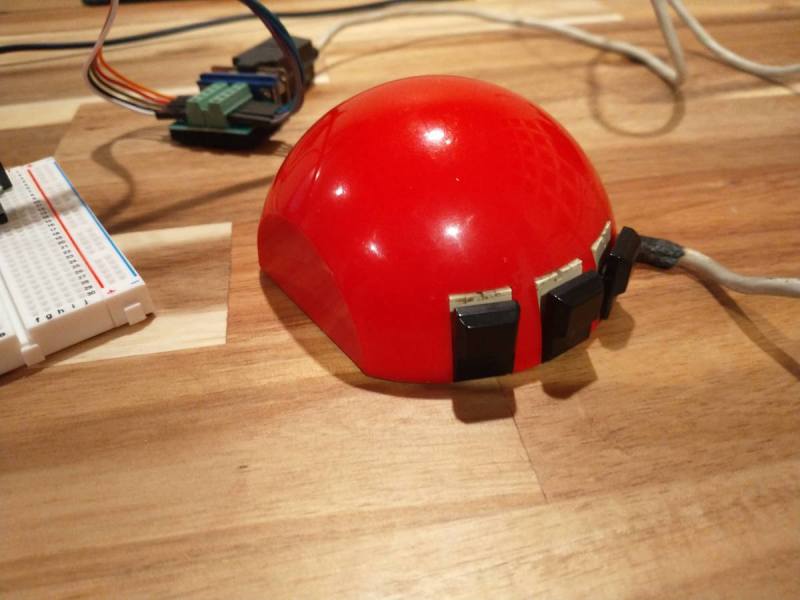When [John Floren] obtained a vintage Depraz mouse, he started out being content to just have such a great piece of history in his possession. But if you’re like him, you know it’s not enough to just have something. What would it be like to use it?
To find out, [John] embarked on a mission to build a USB adapter for his not so new peripheral.
Originally used in very early terminals with a Unix GUI, the Depraz mouse utilizes an unusual male DE9 connector rather than the more familiar female DB9 used in RS232 serial mice. Further deviating from the norm, he found that the quadrature encoders were connected directly to the DE9 connector.
Armed with an Arduino Pro Mini Micro and some buggy sample code, he got to work. The aforementioned buggy code was scrapped and a fresh sketch for the Arduino Pro Mini Micro gave the Depraz mouse the USB interface it lacked. [John] also found that he wasn’t the first hardware hacker to have modified the mouse for their use. Be sure to read to the end the article to find out about the vintage surprise lurking in the mouse shell itself! A demonstration of the mouse in action can be seen in the video below the break.
Looking for a fun mouse hack? Perhaps you’d like to use your more modern USB mouse on a retro computer, or try your hand at recreating an early Apple mouse for use in modern computers.
















“Further deviating from the norm, he found that the quadrature encoders were connected directly to the DE9 connector.”
So it’s something like an Amiga mouse?
Yep, exactly. You should be able to use the same code (not like there’s much of it) for an Amiga mouse, although I’m sure the pinout is a little different.
I don’t think it was uncommon, unless “common” refers to some buffering.
The original Mac mouse just brought out the encoder and switch, though through buffers. I once bought a used mouse, brand unknown, that just brought out the encoders, and by rewiring, it worked with the Mac.
I never looked in my Atari ST, but assume it was simple.
When mouses arrived for home comouters, I wasn’t buying. But I remember both serial and parallel early on. I can’t imagine parallel mouses having much more than the encoders. Serial mouses I suspect needed something to combine the encoder outputs, but don’t know.
But once mouses became standard, they were using PS/2 and ADB standards, which did require the mouse to be “smarter”. Thiugh by then a tiny IC did all the work.
And the Atari ST mouse, the Acorn Archimedes mouse, the PC bus mouse, …
I think it was the norm at the time?
“the Depraz mouse utilizes an unusual male DE9 connector rather than the more familiar female DB9 used in RS232 serial mice.”
That sent me off looking for the difference between DE9 and DB9… and there isn’t any. When PCs switched from DB-25 to DE-9 the new port was often called DB-9 by mistake. Eventually that stuck, so now DB-9 refers to the same connector as DE-9.
Luckily there never was a true DB-9, since a 9-pin connector using a shell big enough for 25 pins would be pretty pointless.
Interesting detail about what was in the mouse – I never knew that.
It looks similar, but with a different pinout.
You just reminded me that it was possible to move the mouse pointer on an Amiga using a joystick plugged into the mouse port. Properly-timed directional inputs could simulate the quadrature encoder output.
Actually getting it to go where you wanted using this method was another matter entirely :)
That was supposed to be a reply to tym0tym…
That is the mouse for an AT&T DMD5620 terminal. DMD for “dot mapped display”, its based on a WE32000 processor and has 1MB of ram. It runs a windowing system called layers, written by Robert Pike. It was a “network computer” in 1985, software would be downloaded to the terminal to execute (the mouse cursor was a cup of coffee while you waited). He would go on to implement 8 1/2, the windowing system for plan 9, which looks just like layers.
Yeah the DMD5620 (or one of the predecessor “blit” terminals) is one of my white whales; always looking for one, unlikely to ever find one.
Typo(s)– not a Pro Mini but a Pro Micro
Updated, thanks!
Thanks for the correction there!
The 5620 mouse is still the most comfortable mouse I’ve ever used.
I had a couple of 3B2’s and a stack of 5620’s in college… But only one real mouse. However I had a pile of old 3B1 mice (and only one 3B1). So I was pulling out the microcontrollers and wiring the encoders directly to the pins. Much to my suprise it actually worked. So sketchy mouse with a ribbon cable tail. We put a few of them in the college terminal room, but I think everyone was scared to use them.
Unfortunately only one 5620 is left. I ported layers to FreeBSD with a large blunt object, modern compilers don’t really like K&R C much, and 64 bit ints make layers and the loader really unhappy. But Some Day I’ll manage to get it to the vintage computer fest.